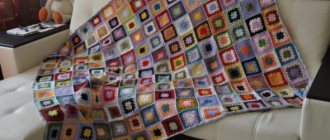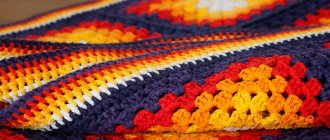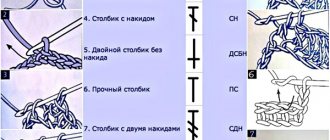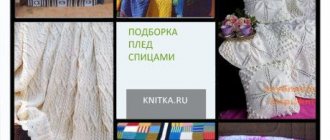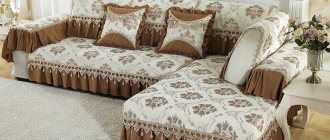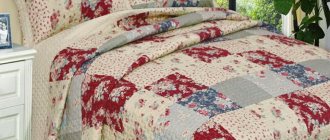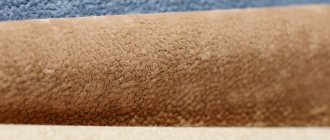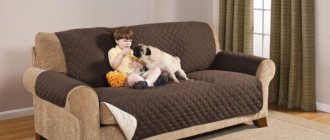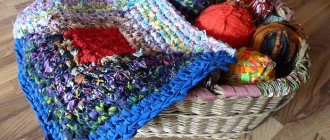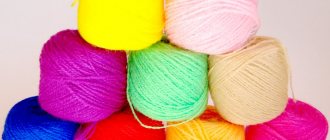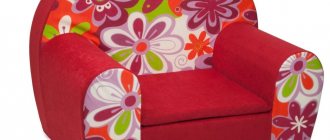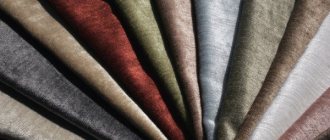Stool seat: video master class
Knitting such a cover for a stool is not difficult and those who have never crocheted before can easily cope with it. At first glance, it may seem that the presented schemes are quite complex, which only experienced craftswomen can understand.
But this is far from true, because everyone can cope with them, and knitting such cute clothes for chairs is not at all difficult. The seat turns out to be voluminous, so it is perfect for a stool without upholstery.
Patterns used
The seat on the stool is made in the form of round flowers. Such crocheted flowers are created in twisted columns with a special hook, needle or on a handle.
Operating procedure
Twisted posts are the basis of such beautiful rugs, so they must be mastered. This can be done with a special hook using a needle or pen. How many such elements are needed? For this you need a stool, or rather the size of its seat, which will be equal to the seat. And since the flowers will be voluminous, you need 2 pieces for 1 motif.
Expert opinion Ekaterina Anatolyevna Smirnova has been engaged in interior design for 7 years, a professional architect
Crochet the finished flowers together and fill them with filler, for example padding polyester. It is not recommended to use cotton wool for these purposes, as it clumps and makes the surface uneven and unattractive.
To assemble individual flowers, you will also have to work with crochet, making a CC. A beautiful and soft rug for the stool is ready.
You can leave it as is, or decorate it at your discretion. It is recommended to make rugs in the same color scheme for chairs in one room, then they will create a beautiful ensemble.
Knitted product
A blanket, which is a single piece of fabric, is usually made with knitting needles. If the craftswoman decides to knit a blanket from a large number of identical modules, it is more convenient to crochet small fragments. Both methods will not take much time; the main thing is to choose a clear and accessible scheme. It is desirable that it be accompanied by step-by-step illustrations. The diagram and description can be of different levels of complexity.
For production you need:
- Cast on the required number of loops.
- Remove the edge loop.
- Knit a row of knit stitches with a purl stitch at the end.
- Make a border from knit stitches.
- Purl a row.
- Turn the fabric over and knit a row.
- Repeat the above steps until the product reaches the desired size.
- Close the loops.
It is recommended to use several colors to create an original pattern on the bedspread. When the knitted blanket for the sofa is ready, its ends are hemmed on a sewing machine. This extends the service life of the product.
Beautiful and comfortable bedspreads for the sofa will become a real highlight of the interior. Handmade products differ from standard ones in their original design, unusual shape and color. This sofa cover will be a wonderful gift for friends or relatives, it will fill the house with comfort and help keep you warm on a cold winter evening.
Hook and yarn
Single-sided check pattern
Knit according to the pattern
Ready product
How to sew a cover for a mini sofa
Not all families have enough space to install a bed. And then a space-saving model comes to their rescue. We are talking about folding mini-sofas. This practical option is most in need of protection. The case for it can be made in the same way as for the classic model. Can be done using the cross method. It uses two parts: the bottom cover and the top piece.
The bottom cover is a rectangular piece of material that completely envelops the furniture. To make it, it is better to use a beautifully flowing fabric, such as satin.
For the top, prepare three pieces of fabric:
- One for the center piece, long enough to reach the middle of the back of the back.
- Two side parts long from the junction of the seat and armrest and to the bottom of the sofa.
Place the prepared pieces on the furniture with the wrong side up and sew with a contrasting thread along the seam line. Sew seams and hem edges. To prevent the side panels from moving, sew weights along the bottom edge. You can also add decorative ties or fasteners that will secure the fabric to the front of the armrests.
REFERENCE! A winning move would be to perform the outer and lower parts in different tones or in a contrasting color.
Another good addition would be pockets sewn onto the cover on the outside of the armrests. You can put a lot of necessary little things in them: a TV remote control, a newspaper or a book.
Advantages and disadvantages
Bedspreads for a corner sofa have many advantages.
- The cape has a protective function. This protects the sofa from spilled tea or coffee, from the hair of your beloved pets, and from various mechanical impacts or abrasions.
- A blanket helps to warm not only the seats, but also the back of the corner sofa. This allows you to rest more comfortably on it.
- Sofa bedspreads also serve a decorative function. After all, if you choose the right cover, you can make the room even more attractive.
- You can purchase covers for corner sofas in specialized stores. In addition, they can be sewn to order and simply knitted yourself.
- The materials for sewing bedspreads are quite varied. This allows you to purchase both summer and winter versions of capes.
- Prices for products differ greatly from each other, which allows each person to purchase for himself exactly the model that fully fits the budget.
- Bedspreads can be made not only from solid material, but also be made using various techniques. For example, it could be embroidery, patchwork, or even bedspreads with appliqués.
- Caring for such textiles is easy and simple. If they get dirty at the slightest level, just remove them and simply wash them in the washing machine.
- Thanks to the bedspread, you can save money on purchasing new furniture or repairing a sofa cover.
Step-by-step master class
To sew a cover for a chair or sofa from thick, practical fabric, you first need to take measurements of the furniture.
Only knowing each size of upholstered or frame furniture can you design the correct pattern. And since we are talking about sewing a full-fledged cover, it is necessary to cut out each detail separately and only then sew all the elements into a common fabric.
Classic model
The easiest way is to cut out and sew a cover for classic sofas and armchairs that have strict rectangular shapes. If the armrests and back of the furniture are streamlined, the sewn cover will need to be supplemented with fixing ribbons, which can be tied with a bow or fastened with large decorative buttons made of natural wood.
If we return to the issue of cutting and sewing, then step by step this process will be carried out according to the following scheme:
Voodoo Doll: A spectacular toy and pin cushion. Manufacturing instructions
- The height, front width and length of the soft seats are measured without taking into account the lower part of the sofa (relevant when the design includes a frill), or together with it if the cover has a straight silhouette all the way to the floor.
- The dimensions of the armrests are measured (heights of the inner and outer side parts, width and thickness). The pattern for this part will have a rectangular shape, while the cover can be either straight or streamlined (depending on the configuration of the armrests).
- Measurements are taken from the back of the sofa. In this case, it is necessary to measure not only its outer and inner height, but also its width, minus the areas where the armrests adjoin.
- Based on the measurements taken, a paper pattern is constructed separately for each part, except for the armrests, since in this case one pattern and its mirror use for opposite sides will be enough.
- The resulting patterns are applied to the sofa to check the coincidence of the seams of the furniture and the paper edge (as well as the accuracy of the patterns).
- The finished patterns are pinned to the back of the fabric and outlined with soap or chalk, after which tolerances are made (the larger, the more reliable the seam will be).
- The products are cut, after which they are basted and stitched together on the wrong side in the same joints as for upholstered furniture.
- A frill is made separately and sewn to the already sewn cover around the entire perimeter.
At the final stage, a sketch of contrasting shades is pulled out from the finished covers, after which the first fitting or adjustment can be carried out, if necessary. The cape can be decorated with all kinds of decor, using twisted braid, heavy velvet tassels and other spectacular elements. It is worth noting that the described algorithm of actions is also useful for sewing a cover with your own hands for a corner sofa , which will have to be supplemented with a rotating element along the back.
Do-it-yourself Tilda doll: step-by-step instructions
Round bed
Modern fashion requires the use of unusual furniture models in the interior. One of them is a round bed, which looks very bright and romantic. In order for a round-shaped bed to look impressive not only at night, but also during the day, it must be covered with a beautiful cover.
There are several interesting ideas that will help you cope with the task perfectly . These include:
- A classic case made of silk, velvet or tapestry fabric. To sew such a cover, two main patterns are used: with a frill and with a straight silhouette. In both cases, it is necessary to measure the diameter of the bed, its height and calculate the circumference. After this, using a needle and a pencil connected by a thread (not everyone has a giant teacher’s compass), a pattern of a round bed is constructed. The lower part of the cover is made separately according to the height and circumference dimensions.
- Fur cape. This option is rightfully considered the most luxurious, especially if real fur is used for tailoring. For example, fox skins make great round blankets if you sew them together, placing the faces in the center of the circle and the tails on the outer part. Lightweight, very warm and wear-resistant - you won't find a better bedspread. If the owners do not have such valuable raw materials available, you can opt for the recently popular faux fur in light shades. And it’s enough just to cut out a circle of the required diameter from a cut to get an impressive bedspread for a round bed or chair seat.
Ready-made covers will look as harmonious as possible if the hostess sews many small pillows with pillowcases made of the same fabric along with them. In addition to the aesthetic side of the issue, this spectacular addition will help solve ergonomic issues, making upholstered furniture even more comfortable for relaxation.
Sequence of work
When making a case, a clear sequence of work is important. Success largely depends on correctly selected materials and a correctly constructed pattern. If you can’t draw a diagram yourself, you should contact a studio or print out a ready-made diagram.
Preparation of tools and materials
Before you start work, you need to prepare everything you need. For a do-it-yourself winter throw on a corner sofa, thick fabric is used; for the summer version, thin materials are used. For sewing you will need:
- matter;
- needle and thread for basting;
- sewing machine;
- decorative elements;
- tape measure.
You also need to prepare sharp tailor's scissors for cutting. Professional tailors use a special marker to transfer patterns onto fabric. It can be replaced with a piece of regular chalk or soap.
Cutting out the parts
Instructions on how to sew a cape begin with cutting the fabric. You can make your own pattern or use a ready-made one. After construction, the drawing must be transferred to the fabric. The cutting is done on the table, carefully laying out the material. In addition to the main fabric, you will need padding (for example, padding polyester) and lining. The recommended width of the product is 2.8 m, the length of the frills is 8.4 m. The padding and lining must match the size of the front side of the main material.
Marking methods: 1 and 2 - markers, 3 - copy wheel and paper, 4 - chalk in a holder, 5 - regular chalk, 6 - tailor's chalk
Cutting fabric
Sewing the product
A pattern is used for sewing. The product is divided into three parts - front, base and lining. Step-by-step instructions include cutting, sewing and finishing. All three parts are made separately and then combined into one blanket. Before sewing a sofa cover on a machine, you need to make a basting manually. A simple “forward needle” stitch is suitable for this. Having sewn the blanket, you need to align the cuts, then mark the frill and sew it on, finishing the cut with bias tape. After this, you can begin the final stage - decoration.
Throw the fabric over the back and seat, pin together at the intended seam locations.
Trim the excess fabric, remove the cover and try it on with the front side, sew on a machine
Sew the folds of the frill on a machine, pin the frill and the bottom edge of the bedspread with pins, stitch
Ready product
Decoration
When choosing patterns and techniques for decorating a sofa cover, you should take into account the features of the interior. You can create an ensemble of blankets and pillows, decorated in the same style. The most popular among modern craftswomen is hand or machine embroidery with dense colored floss threads. The subject of the images is as follows:
- floral ornament (leaves, flowers, curls);
- decor from repeating simple geometric shapes in ethnic style;
- subject embroidery (depiction of genre scenes);
- stylized figures of fish, birds, animals, dragonflies or butterflies.
In addition to embroidery, needlewomen often use appliqué. It is made from small fragments of leather, thick textiles, natural or artificial fur. If the blanket does not have frills, homemade tassels are usually tied instead.
Satin edging ribbons are often used as additional decoration. Fringe, ruffles and bows look good. Braid and ribbons, decorative rivets are used as fasteners. The most practical options are rubber bands and silicone sheets. Some craftswomen use Velcro, but they quickly become dirty and become unusable.
Machine embroidery
Hand embroidery
Application
Ruffles
Fringe
Types of furniture covers
However, buying a ready-made cover is not so easy, even if the furniture owners are not limited by budget. And all because it is extremely difficult to choose an accessory that is ideal for a specific model. An exception is ordinary capes, but they are less practical and convenient to use, since a rectangular piece of fabric will not be able to cover the entire sofa and will constantly slide off its surface.
Fabric covers
There is another option to get the coveted case, which consists of individual tailoring to order. However, it also has one significant drawback, which is the considerable costs of materials and their processing. In addition, it is far from a fact that the studio will do their job quickly and efficiently, because sewing a continuous cape requires constant adjustment, which is almost impossible to ensure if there is no furniture nearby.
That is why it is much easier to sew a Euro-cover for a sofa with your own hands, constantly taking measurements from it and applying the cut parts to the furniture, which is very convenient and useful for a successful result. Don’t be afraid of the complexity of this process, because there are several easy ways to sew a sofa cover that even a novice craftswoman can do.
Before you start cutting and sewing, you should think about what exactly your dream bedspread should turn out to be, because the harmony of the entire interior depends on this detail. Currently, the most popular models are:
- One-piece case without fasteners. As a rule, such models completely replicate the furniture silhouette with a small margin, so they are quite easy to take off and put on. At the same time, they “sit” firmly on the furniture, without sliding off it after someone sits down or stands up, which is very convenient. As for the design, such cases can have not only a strict geometric silhouette, but also a flirty frill around the entire perimeter. Usually the first option is made from dense simple fabrics such as coarse linen or cotton, opting for plain fabrics in light pastel colors. But for the second model, it is better to choose a colorful fabric with a floral print, which is ideal for interiors designed in the style of shabby chic and Provence. In addition, you can sew stronger and more durable, but no less elegant, covers from thick tapestry fabric, which is a good old classic that goes well with natural wood, baroque ornate patterns and crystal chandeliers. If you need to make a child’s pattern for a chair cover with your own hands, then you should take a closer look at the easy and simple patchwork technique made from colorful scraps taken from different fabric cuts.
- If you don’t want to bother with frills and straight floor-length silhouettes that are quickly trampled by guests, then you can make your own sofa cover with an elastic band that ensures a rigid fixation of its edge under the seat. The principle of sewing the upper part of such an accessory is no different from the model described, while its bottom is made shorter with folds in the corners or along the entire perimeter, necessary to thread a wide elastic band. If desired, you can replace the elastic with fabric or twisted ribbons, using the hem as a drawstring.
- There is another option for sewing a sofa cover, the peculiarity of which is the use of special rubberized fabrics over the entire area. This material is quite dense, but at the same time it stretches very well, completely hugging the surface of upholstered furniture. The only drawback of rubber covers is that they require additional fixation in the area of furniture seams, which is not always possible to provide. There are two ways to solve the problem, the first of which involves making each element separately (seat, back, armrests) without further joining them into a common fabric, while the second involves abandoning the sewing of rubber bedspreads in favor of models made from ordinary non-stretch fabrics with a rubberized edge or a frill at the bottom.
How to sew a tunic without a pattern?
The most popular fabrics for permanent or removable furniture upholstery are velvet (velor), natural suede, tapestry, plain and Teflon flock, cotton (cotton), microfiber, jacquard and chenille.
When using a combination of different fabrics for sewing patchwork bedspreads, it is recommended to choose those materials that will have approximately the same density and thickness, otherwise the finished product will very quickly become unusable, stretching or even losing its integrity in certain places.
Knitted blankets
Perhaps the most stylish removable covering for upholstered furniture today are handmade knitted bedspreads. Such blankets turn out to be very delicate, fitting perfectly into the interior of bedrooms and children's rooms, and it is on a knitted cover that it is most comfortable to drink coffee with milk, play with a child, read colorful books or just hug.
The most commonly used models are the following, which you can easily make yourself:
- Fine knit jacquard blankets. These bedspreads are suitable for cribs and chairs, as they are made from thin yarn. Most often, capes are made in light pastel colors, making them monochromatic, although it is quite acceptable to combine two or more contrasting shades. Checkerboard blankets look very cool, divided into separate sectors, each of which is knitted using different techniques (one square with stockinette stitch, the second with garter stitch, the third with aran stitch, etc.) or filled with delicate monochromatic or colored jacquard patterns (bunnies, snowflakes, hearts , starfish, etc.).
- For stylish loft, minimalism and hi-tech interiors, voluminous capes are made from the thickest cotton yarn. This pleasure is not the cheapest, so it is better to buy threads and knit such a blanket yourself, especially since due to the thickness of the material, the work time is reduced to several days. Most often, for knitting bedspreads from the thickest yarn, stockinette or garter stitch is used. The finished product looks both catchy and gentle, suitable for both a woman’s bedroom, decorated in light colors, and a brutal bachelor’s apartment. In this case, you need to knit from thick yarn either with giant wooden knitting needles or by hand, using the same technique as for crochet, only pulling out each new loop by hand.
Patchwork mosaic or patchwork is the key to home comfort
The undoubted advantage of knitted blankets compared to sewn ones is that they are much easier to adjust to furniture, and this is especially true when it comes to models such as click-clack (a sofa that transforms into a bed and vice versa) or solsta with its rectilinear geometric forms. In addition, the product can always be remade by undoing the row in which the mistake was made. As for the disadvantages, the main one is the washing properties of the blanket, because knitted items tend to shrink, stretch and dry for a long time, often “suffocating” after hand washing and a weak spin.
Multi-colored mat-cover from a granny square
Such cheerful and bright rugs are sure to create a great mood for the whole day, even if the weather outside is the most inclement. It is based on a granny square, which always looks advantageous and has a special warming aura. Knitted rugs can be created from leftover yarn, which is not enough for a full-fledged product, but there is nowhere to adapt it.
Materials
It is supposed to work from the remains of any yarn, it is advisable to select it of the same thickness and slightly combine colors. Hook No. 4.
Patterns used
Knitting rugs in this case is based on the granny square. True, each individual element is not a square, but a hexagon. There should be semicircles along the edges of the product.
How to make a rug for a stool?
You need to start by creating a granny square, that is, individual elements of future rugs. And the sequence of work is as follows: 1st row: cast on 3 air loops (VP) and connect them together using a connecting post (CC).
Make 2 lifting loops (PP). 2 rows: then in each loop of the base, cast on 3 double crochets (DC) + 2 PP.
3 r.: 1 VP, 4 SSN, 1 VP. Continue this motif until the end of the row.
When the circle ends, knit a SS to connect the beginning and end of the row. Finish work on this element.
One hexagon is already ready, it can be made in one color, or you can add a thread of a different color. For example, you can make the middle one color and the rest another.
For a stool you need so many squares to cover its surface. And in order for the fabric to turn out even, you need to crochet more semicircles according to this description: 1 p.: dial 3 VP, enclose in a ring.
2 r.: in each loop of the previous circle, knit 2 dc. 3 r.: 1 VP, 4 SSN, 1 VP - continue to the end.
Fasten the thread.
When the required number of elements is ready, connect them to each other with a crochet hook using SS. But this is not all the work, since the strapping still needs to be done.
Tie the resulting fabric with a sc. After completing the first circle, dial 2 VP, the next row is Dc.
Knit tightly, do not make unnecessary increases in the corners, then the seat will fit perfectly on the stool. Complete the work with arches of 3 VPs, which are repeated after 4 columns.
All that remains is to make the fringe. For it you will need even pieces of yarn used for work.
Thread the pieces into the arches and tie a knot with a crochet hook.
Knitted cape for a corner sofa
Lately, knitted items have not left the fashion Olympus. And this applies not only to clothing and accessories, but also to decorative interior items. For many needlewomen, it will not be difficult to knit a beautiful and unusual cover for any sofa. To create this exclusive item you will need yarn, a knitting tool and a knitting needle for assembly. You can do the job:
- Crochet. To do this, knit the required number of elements and connect them together during the knitting process or sew them into a single fabric using a needle. The combination of geometric motifs and contrasting colors looks especially impressive. It is easiest to work with squares, diamonds, triangles and hexagons. Color transitions can be made in the form of a checkerboard or various stripes: diagonal, vertical or diagonal.
- Knitting needles. Using the pattern, the details of the product are knitted in the pattern you like. They can be made as a single piece or consist of interconnected strips. Then the elements are sewn together using a knitting needle. A variety of aranas are best suited for such things. It is not necessary to make each stripe with the same pattern; on the contrary, by combining different patterns you can get an extraordinary and stylish case. In addition to various weaves, you can use jacquard patterns and ornaments. The latter type will serve as an excellent finish for the bottom of the product.
The fabric should be quite dense, and it is advisable to place the finished product on a lining. This way it will last longer without losing its original shape.
You also need to be careful when choosing yarn. After all, this thing will have to be washed periodically. Therefore, choose the material that is easiest to clean. The best option would be to use high quality acrylic. Be sure to perform a wet-heat treatment of the sample before calculating the knitting, since many types of this material can shrink when washed.
REFERENCE! A crocheted item will require more yarn than a knitted item.
Knitted capes look great when complemented with various decorative decorations: fringe, lace or large beads. They wonderfully decorate the possessions of a creative person. And their implementation and appearance depend only on your desire and imagination.
Benefits of self-knitted curtains
There is a widespread belief among housewives that knitted curtains for the kitchen are impractical, that they absorb grease from cooking and require constant care. But at the same time, they ignore how unique such canvases look on the windows. Even if crocheting is not your thing, then if you want, finding such curtains in a special store is not a problem. And for a unique interior, you can order a personal version.
To make your own knitted curtains for a nursery you will need to spend a lot of time, but this is the cheapest and most practical option. Moreover, if you do not know the technology, you will have to study it. But the advantages of this are obvious:
- Cheap, you just need to spend money on materials;
- Uniqueness, since you choose the design yourself;
- Possibility to weave a curtain from high-quality threads chosen independently.
Tips for beginners
In order for a knitted product to serve for many years and delight its owners, you should take care of the yarn. For work, it is better to choose synthetic yarn, for example, acrylic or cotton with the addition of synthetic fibers. For the crocheting process, it is recommended to use thicker threads. This is necessary to ensure that the rug fabric is dense and warm. Accordingly, you need to choose a larger hook. Before starting work, you need to knit a sample, a small square, wash and iron it. This technique will help with determining the size of the finished product. When the sample has dried, you need to measure it and, using a simple arithmetic proportion, calculate the number of loops that are needed to obtain a rug of the required size.
You can choose any knitting pattern. The main criterion is its attractiveness. You can even use a diagram for a napkin, or any other one you like, as well as use the diagrams and descriptions presented below.
Small scraps of yarn of different colors will make a rather attractive and interesting rug. This technique will allow you to use the accumulated remnants of threads that are a pity to throw away, but you won’t be able to knit anything from them. But it is worth remembering that the thickness of the thread should be the same over the entire surface of the product.
Related article: DIY credit card wallet
In order for the product to serve longer and maintain its appearance, you need to make a base for the future rug from dense fabric. If the rug is of insufficient size, the situation can be quite easily corrected with the help of a border. The rug must be tied around the perimeter with the required number of additional rows.
In order not to have to unravel the knitted rug and redo part of it, you need to carefully follow the icons in the diagram.
How to sew a cover for a corner sofa with your own hands
Corner models are one of the most widely used types. They are comfortable, stylish and fit into any interior. But unfortunately, they are also subject to contamination and wear. And despite the apparent complexity of the design, building protection for them is not so difficult. There are several ways to do this job:
- Using the first method for a classic item, but making the back and seat in two parts. They are joined to each other at right angles or diagonally.
- The second method involves using two pieces of fabric that are joined in the center of the corner piece.
- Each part of the sofa has its own cover: left, right and corner parts. Then they are sewn together from the inside out.
ATTENTION! When choosing fabric for sewing protection for a corner sofa, you should pay special attention to the pattern. Solid colors or a small chaotic pattern are ideal. Stripes are best avoided. The same rule applies to the texture of matter.
How to crochet a cape with your own hands
Before starting work, you need to decide on the shape of the future product. It can completely cover the entire sofa or without armrests; it can be intended only for the seat or, conversely, only for the back of the sofa.
Knitting with your own hands is a fascinating and interesting process.
In addition, the cape may not be attached to the furniture in any way or may have an elastic band around the perimeter. An option with Velcro fastening is also possible. You also need to choose a fabric and color that suits your interior.
High-quality knitting threads provide good results.
Some designers advise, on the contrary, to play with contrast - for example, for a white interior, knit a blanket from gold or blue yarn, and for a light brown interior, use dark red or green threads.
A modern throw is considered the ideal solution for any sofa.
Preparing for knitting
Search online on websites or forums for patterns for crocheting a sofa cover and you will see that you can use different patterns. Their choice is quite wide - from the simplest to the quite complex. Therefore, both experienced and novice needlewomen will be able to choose an ornament that is suitable for their level of skill.
For crocheting, the most universal pattern is considered to be squares. Firstly, it is not difficult and can be performed by a person with any level of skill and technique. And secondly, this pattern is suitable for interiors of most styles.
For modern modernism or minimalism, a bedspread of restrained colors and not too pronounced texture is suitable.
First, we recommend trying to knit a rectangular-shaped throw for a standard sofa.
A more complex option is a cover for a corner sofa. With this option, we recommend knitting two rectangular parts first, and then connecting them.
Knitting motifs are the most popular.
If you compare some description for a sofa bedspread with crocheting patterns for a chair cover, you will see that the difference is only in size.
Knitting technology
Let's look at how to crochet a sofa cover with a pattern of squares for a regular rectangular sofa in stages:
- Choose a type of yarn. In our example, it will be 100% acrylic with a nominal yarn thickness of 100 g / 210 m;
- More beautiful products are obtained when using multi-colored threads, so for our cape we will take threads of two colors - green and yellow;
- Calculate the required number of skeins. For our cape you will need 14 skeins of 100 g of each color;
- Choose a suitable crochet hook. To make a cape, it is best to use hooks of medium thickness;
- Tie 32 squares according to the pattern (16 pieces of the same color), tie each of them around the perimeter with single crochets. The number of squares (motifs) depends on the size of the sofa and the size of the side of the motif itself. In our case, its side is 25 cm. Thus, the length of the cape will be 8 motifs, and the width will be 4 motifs;
- With exactly the same pattern, you need to knit 4 triangles of each color with the side of the base of the triangle equal to the side of the square;
- It is necessary to connect all the motives with each other. To do this, fold them in pairs with the right side out and connect them using a single crochet hook, resulting in a beautiful ribbed seam on the front side. To connect with an invisible seam, fold the motifs with the right sides inward and connect them with half-columns. Combine the triangular motifs with the squares at the bottom of the cape, forming a scalloped edge.
A cover for a sofa or chair not only decorates the furniture, but also protects its upholstery from damage, dirt and wear.
Exactly the same principle is used to crochet a chair cover. This completes the main part of our bedspread.
Final stage
At the final stage of work, it is necessary to decorate the resulting cape. For example, you can decorate it with fringe or make decorative tassels.
Decorative tassels will decorate your blanket.
In our example, triangles were made at the bottom of the cape, to the tops of which we will attach tassels made from threads. Making fluffy and short tassels is very simple. To do this, take a regular book and wrap yarn across it. On one side of the book, cut the yarn, and on the other side, pull the resulting bundle with thread and tie it beautifully.
There are many patterns and patterns for knitting, both simple and complex.
When knitting, you can use bouclé threads or grass yarn. Their special texture will help hide unevenness or mistakes made while knitting. This is especially useful for beginner knitters.
Colors and materials
With the help of a cover for an armchair and sofa, you can refresh and diversify the interior of the room.
The advantage of beige color is harmony with all colors
You can use this. For a bright and contrasting effect in a white interior, add a rich blue bedspread, curtains mixed with small decor.
Red is the color of aggression, be careful with it and do not use it with other contrasting, saturated shades. It is important to consider the placement of windows in your room. If they are on the south side, go for cool shades; windows facing north bring warm tones.
The advantage of beige color is harmony with all colors
Many people use this trick when buying double-sided bedspreads. In this case, you can use variety and change shades with the seasons. Harmony must be maintained, so the shade of the bedspread must be supported by at least one element in the room, for example, curtains or decorative items.
Capes will help change the atmosphere of your home
A few one-way throws can help change the atmosphere in your home. They choose summer colors - light, pleasant tones, and in the same way they take winter ones as a replacement, they will be brighter, more juicy. Summer options include vanilla color. Winter, for the Christmas mood will go coral, chocolate.
Crochet a square rug for a chair with diagrams and descriptions
Square-shaped stools are often found in our everyday life, so such a rug will certainly be useful to many.
For knitting you will need several colors of yarn: from white to dark shades of any color and a hook.
- We form the first circular row. To do this, we make a ring from the working thread and knit three chain stitches. Next we make a square: 2 columns s/neck, 3 v.p., 3 columns s/n., v.p., 3 columns s/n., 3 v.p., 3 columns s/ nak., 3 v.p., conn.st. into the third lifting loop.
- The next row is 3 vp, then from each arch of the bottom row we knit 3 sts/s, 3 chs, 3 sts/s. In the last arch we make 2 pillars. and conn. column in the third point of the rise.
- Then again 3 ch, and knit the elongated loops two rows below (now this is the center): yarn over, hook the thread through the center, pull it out and knit a stitch.
Then another 1 column.s/nak.
From the corner 3 columns with / on, 3 v.p., 3 columns with / on.
The next side is from the middle of a group of 3 pillars. we knit 3 stitches, the middle one with an elongated loop. Then we repeat from the corner arch to the end of the circle.
- The fourth row repeats the same as in the third, only we make the elongated loop correctly, because the two rows below are now between the first and second rows.
- In each subsequent row, the number of column corner groups increases, and on the sides - the number of elongated groups. loops. At the same time, we change the color of the yarn, creating a contrast of elongated loops against a background of a different color.
Another tip: you don’t need to tighten the loops so that the sides don’t pull towards the center.
Having reached the required size, we knit 4 rows without stretching. loops, and in the corners only columns. - these are the sides of the rug.
You get such interesting touches.
The benefits of making it yourself
Handmade light green bedspread for a sofa
Recently, handmade products or, as they are often called in the English manner, handmade, are increasingly attracting attention. And it is quite understandable: gone are the days when people did knitting in order to dress their household, or even earn a little money. Today this side of knitting has not disappeared, but needlework has ceased to be only a source of income.
The knitted blanket fits perfectly into the interior of a country house
Making crocheted or knitted products allows you to:
- choose the most suitable shape of the model of the appropriate size;
- independently decide on its color scheme;
- always keep up with the times, making the most fashionable things;
- make an exclusive bedspread with an original knitting pattern;
- do not have a strict time reference;
- purchase materials for work of the required quality and in the required quantity.
Unique handmade plaid in a marine style
This does not limit the benefits of products made by home craftswomen with their own hands. An important aspect is the significant savings on their production.
Knitted blankets are special types of bedspreads, such models are made from hypoallergenic material that does not irritate the skin
